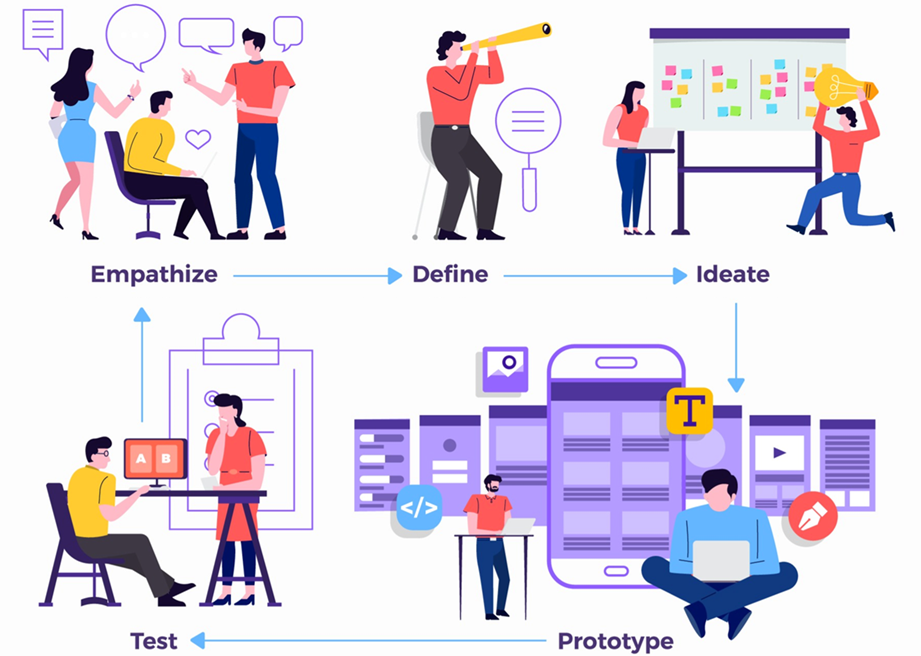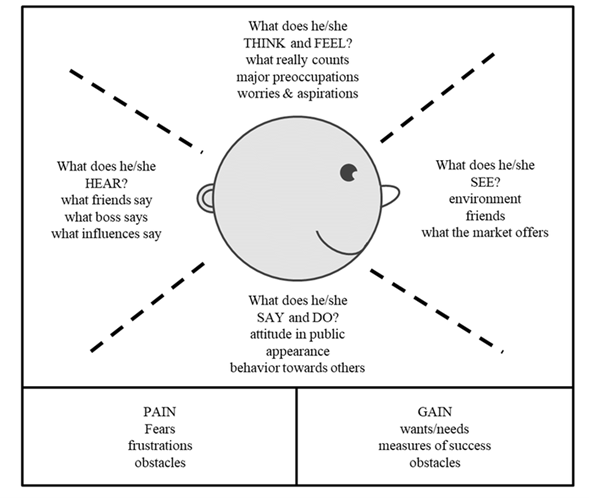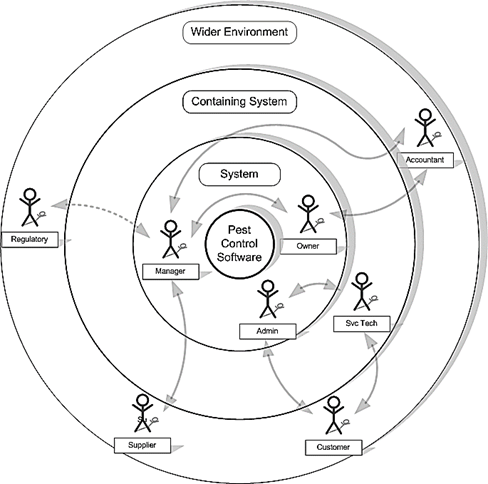
Design Thinking and Project Management
What is Design Thinking?
Design thinking is a methodology that was created by Stanford University professor Tim Brown and IDEO’s CEO, an innovation agency where they wanted to improve the service to their customers, from an empathy approach. Every time, the method proposed in Design Thinking is being used all over the world, especially in organizations that want to solve problems, focused on clients, based on ideas, proposals, and experimentation, above all.
This dynamic occurs even when the ideal of the final product or deliverable is not yet clear, but if the problem is clear and the work of experimentation with the final customer is enhanced. This way of solving problems has stages, but without a doubt its basis is the focus on the needs of the client, empathizing, observing, evaluating, creating prototypes (experimentation), testing, getting feedback, and improving the product.
This process allows sustainable growth and is based on teams from multiple disciplines, to achieve products or services, technically feasible, that meet the expected and within the resources available.
The process.
Through the different design thinking phases, we can use a series of technics and tools that allow us to develop new products and services, from understanding problems or needs to prototype, business model, evaluating alternatives, client feedback, etc. It is important to punctuate that this is an iterative process.

Figure 1. Design Thinking Steps
The stages are briefly described for comprehension purposes; however, I will focus on the “Empathize” stage and its tools to improve the lifting of the client’s need, their desires, knowing their “pain” and how to plan possible solutions. Independent of the project approach: predictive, agile, or hybrid.
- Empathize:
This stage is perhaps the most relevant, because it focuses on understanding as a team and individually, the desires and incentives that the client has, beyond the need itself. Here is much of the success of this method, as it drives you to know customers or end-users deeply. Considering, of course, the “hard” data, figures, fixed strategy, business plan, which are important because they are the “context” of the problem, but it is not the primary objective of empathizing.
This empathy is achieved by engaging with end-users or customers. Getting your point of view and ideally living it. Several tools and techniques of this stage are those that I will deepen in this article.
- Define:
In the first stage, we should be able to obtain the main problems posed by the user/client with the necessary depth. It is then necessary to evaluate the information obtained and detail the one that contributes to a greater extent to really know the users. Here are defined those hypotheses that present greater opportunities to generate value to the client when solved.
- Ideate:
It is now up to elaborate ideas for the problems selected from the previous phase, the focus is to look for a range of solutions, there is no “bad idea”, the more alternatives the better for the process. Brainstorming is crucial at this stage, the best one for the team and its characteristics are sought, considering of course the users/customers. As the name suggests, in this phase the solution ideas are worked on, and collaboration and participation of all team members are encouraged.
- Prototype:
As the name implies, here ideas are transformed into prototypes. It pursues further experimentation by the team and customers. Prototypes can be made with common materials such as paper, cardboard, Lego blocks that reflect functions of the final product. Or in the case of digital prototypes, app demo.
- Testing:
Here the tests with the prototypes made are carried out and the users/client are asked for their feedback regarding the experimentation with the prototypes. This stage allows to identify improvements, failures, deficiencies, good points that must be maintained, etc. Ideal to maintain as a team a receptive look at the interaction of users with the prototype, answer inquiries and documents.
- Evaluate:
Here it is necessary to analyze the errors, and observations obtained from the previous stage, looking for the points of improvement of the product. This can lead us to go back to previous stages with the improved products and experiment again until we get to the closest thing to the product desirable by the user/customer.
Advertisement
[widget id=”custom_html-68″]
Design Thinking Tools.
Independent of the project approach: predictive, agile, or hybrid. Especially for user “requirements” or “stories”, the following tools or techniques add a lot of value in complementing and fully identifying the customer’s desires.
- Empathy Map: this is one of the most useful and applicable tools to get to know our customers/users in depth. It allows delivering a global vision of the aspects of the “human being” behind the client.
It is a canvas like the one presented below, which can of course be complemented with the areas that as a team we determine valuable for our process, this gives us benefits such as:
-
- Improve the understanding of our customers or users.
- Have a dashboard view of customer needs
- Land expectations and document them.
- The visual saves a thousand words.
- Develop the products considering the map obtained.
- Enhance the lifting of requirements and enrich user stories.
- Allows you to engage in the client’s “pain” and experience their concerns.

Figure 2. Empathy Map
- Job Shadowing or Observation: focuses on observation, supported by an interview with stakeholders or users who carry out the activities of the business flow that is part of the client’s environment. Example: A shoe factory would mean observing (not just talking or interviewing) all those roles that are part of the required business flow. In IT or Technological industries, for example, it is common for metrics such as:
- A number of interactions carried out by users in the system or application they use as part of the process to be surveyed.
- Failures or points of failure of the system or application.
- Execution process times of the functionalities of the system or application.
- Of course, everything is related to the customer experience.
Benefits: observing that it goes beyond the story, the daily operation of the organization (in-situ), allows to know, document, and see the critical points of the flow and what can be improved. There is no better feedback than from the first source, experiencing and evidencing the activities that will be the focus of intervention of our project, allows us in addition to documenting the current flow, to know the “pains” of the user (client) and their expectations.
- Actors Map: it is a graphic representation, very simple, that allows concentrating in the same plane, the interactions, degree of involvement, and the relationships of the actors that relate to our main client. All this is in the context of the problems that are being tried to develop.
There are several ways to represent this map, the example described below is circular, which is segmented into three parts depending on the areas of the customer relationship, segmentation is according to our need.

Figure 2. Actors Map
Source: http://tynerblain.com/blog/2007/03/13/visualize-stakeholder-analysis/
Another important point is that the gaze of actors is also equivalent to those interested in the project such as people or institutions, private or public.
They participate in this diagram:
- Direct actors: they interact directly with our client (in the center). We can associate them with greater or lesser influence.
- Main actors: they are related and interact with our main client; they have lower interaction, and you don’t have so much control over them.
- Secondary actors: they are related and interact with our main client, in a distant way, but may or may not have influence and relevance. They are unpredictable.
Design Thinking in Project Management
In projects, independent of the approach, we can innovate, with tools or techniques that are not necessarily the traditional or usual ones for our projects. Precisely in times where the dynamism of the market and the behavior of our customers, we must have the ability as a team and organization, of course, to adapt and use those techniques that facilitate our day to day and allow us to get to know our users or customers who are finally the main focus of our activity.
In this context, we can use this tool to define:
- Customer needs
- The product features
- The project scope
- Design business process
- The IT architecture
- Requirements analysis
This approach helps us to identify stakeholders, improve the process to select projects, reduce conflicts, innovate in a changing world, solve complex problems, and we can work to satisfy needs and increase value to the business.